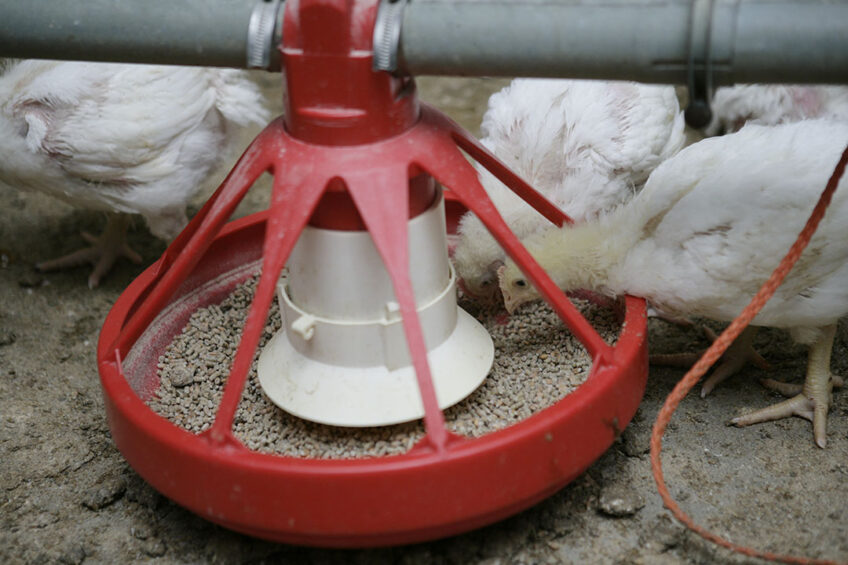Fulvic acid reduces ammonia emissions in broilers

In a recent study, fulvic acid proved beneficial to broiler production by inhibiting urease activity and reducing the ammonia released through faeces.
Fulvic acid is extracted from weathered coal, brown coal, and other minerals, forming a compound organic acid with high bioactive properties but low molecular weight. Fulvic acid and humic acid are the 2 major components of the humus, which have similar functional structures. Fulvic acid consists of numerous active functional groups including phenol, hydroxyl, carboxyl, and hydroquinone, which confer beneficial effects such as anti-inflammatory and antiviral activities.
Diets
In this study, researchers examined the effects of mineral fulvic acid at different concentrations on faecal ammonia excretion, production parameters, intestinal function, and digestive enzyme activity of Arbor Acre broilers from one day old to 42 days. The broilers were housed in 3-tiered battery cages with 24 h lighting, and free access to feed and drinking water. The broilers were divided into 4 treatment groups as follows:
1. The control (CON): a basal diet, no additive.
2. Control + fulvic acid (FA) at varying levels of 0.15% FA, 0.3% FA and 0.5% FA.
Ammonia excretion
For the faecal ammonia test which lasted for 5 days (Figure 1), the addition of FA at the 3 different inclusion levels resulted in a significant reduction in ammonia excretion which was observed on day 2, while the 0.5% dietary FA also significantly reduced the faecal ammonia yield compared to the control treatment on days 4 and 5. Thus, there was a noticeable linear effect on 2 d, 4 d, and 5 d, such that with an increase in dietary FA levels, the amount of ammonia released in the faeces decreased.
Figure 1 – Effects of fulvic acid on faecal ammonia emission and urease activity.

Their results also showed that at 1 d and 3 d of the faecal ammonia determination, the faecal urease activity was significantly reduced with varying levels of FA addition (0.15, 0.3, and 0.5%) compared to the unsupplemented group. The researchers attributed the effect of ammonia reduction on the potential of fulvic acid to modulate gut microbiota that was observed in this study. In addition, the reduction in ammonia excretion was related to its enhancement of nitrogen metabolism and riboflavin metabolism that was also observed in this study.
Intestinal function
Compared to the control treatment, it was observed that the addition of 0.15% FA significantly increases the villus height to crypt depth ratio of the duodenum of broilers. In the ileal mucosa, the content of the tight junction proteins occludin and zonula occludens-1 was noticeably greater in the 0.15% FA treatment than in the control treatment, indicating improvements in the intestinal barrier function. In addition, it was observed that the antibacterial mucin-2 in the ileal mucosa was elevated in the 0.5% FA treatment compared to other treatments, whereas, in the jejunal mucosa, it was significantly increased by all of the inclusion levels (0.15, 0.3, and 0.5% FA), further confirming its enhancement of the mucosa barrier function of broilers.
The researchers highlighted the fact that, consistent with the current findings, previous studies had shown that feeding humic acid increases intestinal viscosity, decreases intestinal permeability, and reduces intestinal bacterial translocation in broilers. Humic acid was shown to have a strong interaction with collagen and other biopolymers, which enhanced the maturity of collagen fibres and increased the integrity of ileal epithelium, further explaining how FA addition served to improve the tight junctions and intestinal permeability of broilers. FA supplementation also resulted in intestinal proliferation of beneficial bacteria such as lactobacilli.
On the other hand, D-lactate dehydrogenase (D-LDH) can be used as an index to examine intestinal barrier permeability. When the body is subjected to trauma, shock, intestinal infarction, long-term stress, and bacterial invasion, the intestinal barrier is destroyed, and a large amount of D-LDH produced by intestinal bacteria will enter the blood circulation, increasing the content of D-LDH in the blood. In the current study, plasma D-LDH was significantly decreased by the addition of 0.15, 0.3, and 0.5% FA measured at 42 d compared to the unsupplemented diet. The 0.15% FA treatment had lower lipopolysaccharide (LPS) concentration compared to the control birds, further confirming the claim that fulvic acid supplementation, especially at low concentrations, improves the intestinal barrier function of broilers.
Digestive enzyme activity
Although fulvic acid had no significant influence on production parameters, it was observed that the jejunal index of broilers increased linearly with an increase in dietary FA levels. Furthermore, the ileal and thymus organ indexes of broilers treated with 0.15% FA increased noticeably more than with the control treatment. In the ileal chyme, the amylase activity was unaffected by the different dietary treatments. However, the amylase activity in the jejunal chyme was significantly stimulated in the 0.5% FA compared to the control and 0.15% FA treatments.
Similarly, it was observed that the addition of 0.5% FA resulted in a significant increase in lipase activity of ileal chyme and jejunal chyme compared to the unsupplemented diet, all pointing to the potency of fulvic acid in enhancing nutrient digestion and absorption.
Concluding remarks
Fulvic acid reduces ammonia excretion through its effect on urease activity and enhancement of nitrogen and riboflavin metabolism.
Fulvic acid supports intestinal functions by stimulating the activity of digestive enzymes, promoting intestinal tight junctions and gut barrier functions, and promoting the colonisation of beneficial intestinal bacteria.
Contrary to previous studies, in this study, the supplementation of fulvic acid had no significant influence on the antioxidant parameters.
The study demonstrates that the addition of 0.15% FA is an appropriate dosage of mineral fulvic acid that is beneficial in broiler diets.
The article is based on a study by C. Tang, W. Kong, H. Wang, H. Liu, L. Shi, V. A. Uyanga, J. Zhao, X. Wang, H. Lin, and H. Jiao. 2023. Effects of fulvic acids on gut barrier, microbial composition, fecal ammonia emission, and growth performance in broiler chickens. Journal of Applied Poultry Research, 32: 100322.











